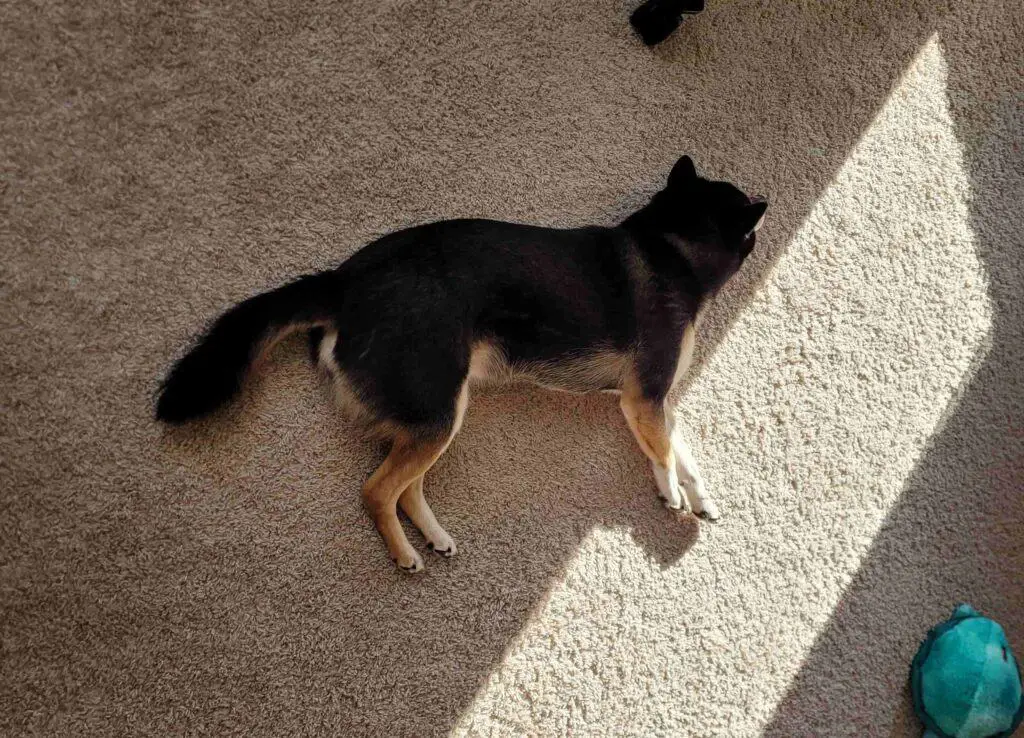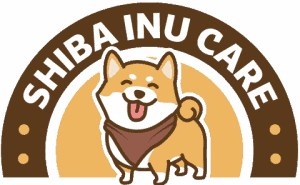This post contains affiliate links.
If you are a dog lover, especially a Shiba Inu enthusiast, it’s crucial to be aware of common health issues that could affect your furry companion. One of the most common canine health concerns is hip dysplasia, and you might be curious if your Shiba Inu is susceptible to this condition.
Fortunately, by understanding the causes and risk factors, you can take the necessary steps to ensure your pet leads a healthy and content life.

What Is Hip Dysplasia?
Hip dysplasia is a skeletal condition that commonly affects many breeds, like Shiba Inus. It occurs due to hip joint malformation, leading to instability or abnormal looseness. The irregular wear and tear of the joint components leads to inflammation, pain, and can eventually lead to arthritis.
Genetic and environmental factors such as rapid growth, excess weight, or injury can contribute to the development of hip dysplasia. Some symptoms your Shiba Inu might experience if they have hip dysplasia:
- Limping or favoring one leg over the other
- Difficulties with climbing stairs or jumping
- Popping or grinding sounds when they move
- Stiffness or soreness after exercise
- Reluctance to be active or play
If you think your Shiba Inu might have hip dysplasia, consult with your veterinarian. Early diagnosis and management can help improve your dog’s quality of life and reduce the risk of further joint damage.
What Can Cause Hip Dysplasia?
Two main factors contribute to hip dysplasia in Shiba Inus: genetics and growth rate. If a Shiba Inu’s parents or close relatives have hip dysplasia, there’s a higher chance that the dog may inherit the condition. Additionally, rapid growth during puppyhood can put extra pressure on their hip joint.
It’s important to monitor their diet and avoid overfeeding with high-calorie foods. Proper exercise is also important, avoiding high-impact activities and maintaining an ideal weight.
Are Shiba Inus Prone To Hip Dysplasia?
Shiba Inus are prone to hip dysplasia, though it’s not as common in this breed as some others. It’s still essential to be aware of the signs and symptoms to ensure your dog gets the necessary care if needed.
Signs Of Hip Dysplasia
As your Shiba Inu grows older, you may notice some symptoms that might point to hip dysplasia. Look for the following signs:
- Limping or stiffness after exercise
- Difficulty rising after laying down
- Reluctance to run, jump, or climb stairs
- Swinging or “bunny hop” gait
- Reduced activity or mobility
These signs can also indicate other health problems, so it’s essential to consult with your vet.
How Shiba Inus Are Diagnosed With Hip Dysplasia
If you suspect hip dysplasia in your Shiba Inu, your vet will perform a physical examination and ask about your dog’s history. They might recommend X-rays to examine the hip joint and determine the severity of the condition.
Diagnosing hip dysplasia early is vital, as it can help your vet develop a treatment plan to manage pain and improve your dog’s quality of life.
Common Treatment Plans
Treatment for hip dysplasia in Shiba Inus depends on the severity and your dog’s age. Some common options include:
- Weight Management: Keeping your dog at a healthy weight reduces stress on the hip joint and can ease symptoms.
- Exercise Modification: Encourage low-impact activities, like swimming, to help maintain muscle strength without causing pain.
- Anti-Inflammatory Medications: Your vet may prescribe medications to manage inflammation and pain.
- Joint Supplements: Supplements like glucosamine and chondroitin can support joint health and alleviate discomfort.
- Surgery: In severe cases, surgery might be necessary to repair the hip joint or replace it with an artificial one.
Remember, always consult with your veterinarian to discuss your Shiba Inu’s specific needs and situation. They can guide you on the best course of action to keep your beloved dog healthy and comfortable in the face of hip dysplasia.
Factors That Can Affect Your Shiba Inus’ Risk
Maintaining the health of your Shiba Inu is essential, and understanding the factors that can affect their risk of hip dysplasia can help. Here are a few things to keep in mind:
Exercise: Regular exercise is crucial to keeping your pup’s joints healthy. Physical activity helps strengthen their muscles, which in turn provides better support for their joints. Just remember, you don’t want to overdo it – stick to moderate levels of exercise to avoid putting too much strain on their hips.
Genetics: Like many health issues, hip dysplasia is influenced by genetics. Some Shiba Inus may be more prone to the condition due to their family history. Thankfully, responsible breeders work to minimize these risks by carefully selecting parents with healthy joint structures. So, when looking for a Shiba Inu puppy, consider choosing a reputable breeder.
Obesity: Carrying extra weight puts unnecessary stress on your dog’s joints and bones. This added strain can contribute to hip dysplasia in your Shiba Inu. To keep your furry friend in good shape, provide a balanced diet and monitor their weight to ensure they maintain a healthy size.
Arthritis: Hip dysplasia often leads to the development of arthritis. This degenerative joint disease can cause pain and inflammation in your dog’s hips. If you notice any signs of discomfort or mobility issues, consult with your veterinarian for an accurate diagnosis and appropriate treatment plan.
Preventative Measures
Schedule regular vet visits to monitor growth and joint health. Consider adding glucosamine and chondroitin supplements to their diet.
Engage them in low-impact exercises like swimming or walking on soft surfaces to strengthen their muscles. Avoid high-impact activities and pay attention to their cues. Regular grooming to trim their nails and reduce itching can also help prevent abnormal gait and joint stress.
Summary
Hip dysplasia is just one of several health problems that can affect Shiba Inus, with other conditions including patellar luxation, cataracts, atopy, hypothyroidism, and various eye issues.
As a Shiba owner, you should be aware that patellar luxation occurs when the kneecap slips out of place, which may cause pain and discomfort. In addition, cataracts and progressive retinal atrophy are common eye problems that may lead to blindness if not adequately treated.
Atopy is characterized by inflammation and a heightened sensitivity to allergens in the environment, which can cause discomfort, itching, and skin issues. Hypothyroidism, a condition affecting the thyroid gland, may cause a Shiba to experience lethargy, weight gain, and hair loss.
Other potential health problems affecting Shiba Inus include elbow dysplasia, heart conditions, and cancer. It’s important to address any observed symptoms early on to ensure the best possible outcome for your dog.
Frequently Asked Questions
What Are Shiba Inus Prone To?
Shiba Inus, like any breed, have their own set of health issues. Some common ailments that can affect your Shiba Inu include:
- Hip dysplasia
- Patellar luxation
- Allergies
- Glaucoma
Do Shiba Inus Have Joint Problems?
While Shiba Inus are not as prone to hip dysplasia as some larger breeds, they can still develop joint problems. This condition occurs when the hip joint doesn’t properly form, causing discomfort and potential mobility issues. Regular veterinary check-ups, a balanced diet, and age-appropriate exercise can help maintain your Shiba Inu’s joint health.
Are Shiba Inus Prone To IVDD?
Intervertebral disc disease (IVDD) is a spinal condition that affects the discs in the spine. Though it is more commonly found in long-backed breeds like Dachshunds, it can also occur in Shiba Inus. Symptoms of IVDD include pain, weakness, or eventual paralysis. Early detection and treatment are crucial, so if you suspect your Shiba Inu is experiencing IVDD, consult with your veterinarian.
Why Is My Shiba Inu Limping?
Limping can have various causes, such as injuries, joint issues, or even neurological problems. If your Shiba Inu is limping, it’s essential to consult your veterinarian for a proper diagnosis. Here are some common reasons for limping in Shiba Inus:
Injuries: Sprains or strains can result from accidents or rough play.
Patellar luxation: This occurs when the kneecap dislocates, causing pain and limping.
Hip dysplasia: Although it’s less common in Shiba Inus than in larger breeds, hip dysplasia can cause limping and discomfort.
Arthritis: As your Shiba Inu ages, joint wear and tear can lead to arthritis, causing pain and difficulty moving.
